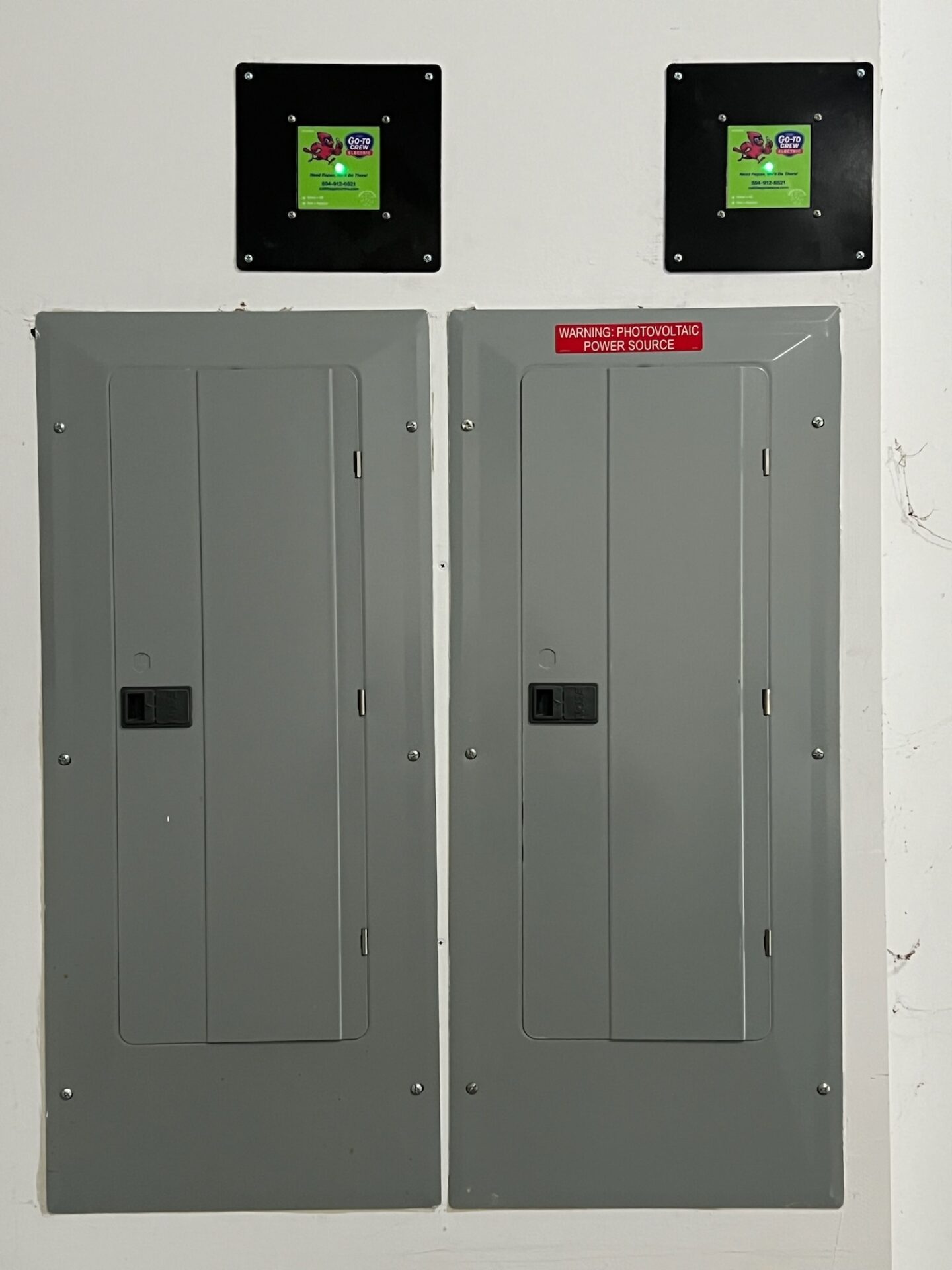Welcome to The Go-to Crew Electric’s exclusive buyer’s guide to subpanel installations! Whether adding new circuits to your home or expanding your electrical capacity for a workshop or addition, understanding subpanels is essential for maintaining a safe and efficient electrical system.
This guide will walk you through everything you need about subpanels, from the basics to critical considerations and expert tips. So, let’s shed some light on subpanel installations together!
Understanding Subpanels
Before delving into the installation process, let’s start with the fundamentals. A subpanel, a feeder panel, or a distribution board is a smaller electrical panel connected to the primary service panel. It distributes power to specific areas or circuits in your home, providing additional capacity and flexibility.
Key Components
- Main Breaker: Controls the flow of electricity from the main service panel to the subpanel.
- Circuit Breakers: Individual switches that control power to specific circuits connected to the subpanel.
- Bus Bars: Metal strips that conduct electricity from the main breaker to the circuit breakers in the subpanel.
- Neutral Bus: Connects the neutral wires from the circuits to the central neutral wire.
- Ground Bus: Connects the ground wires from the circuits to the primary grounding wire.
When Do You Need a Subpanel?
You may need to install a subpanel in your electrical system under various circumstances:
- Increased Electrical Load: If you’re adding new circuits, appliances, or outlets to your home or business and your main electrical panel is nearing its capacity, installing a subpanel can help distribute the load more evenly. This prevents overloading the main panel and reduces the risk of tripped breakers or electrical hazards.
- Renovations or Additions: During home renovations, expansions, or additions, you may require additional electrical circuits to power new rooms, appliances, or features such as outdoor lighting, a workshop, or a home theater. A subpanel can accommodate these extra circuits without overburdening the main panel.
- Separate Areas or Structures: If you have detached garages, workshops, guesthouses, or other outbuildings that require electricity, installing a subpanel in each structure allows for independent electrical distribution. This is more convenient than running long feeder cables from the main panel and ensures sufficient power for each area.
- Specialized Equipment: Certain appliances, such as an extensive HVAC system, hot tub, or home office with extensive computer equipment, may require dedicated circuits or higher electrical capacities. Installing a subpanel dedicated to these devices ensures they receive the power they need without affecting other circuits in the main panel.
- Code Compliance: In some cases, local building codes or electrical regulations may require the installation of a subpanel to meet safety standards, mainly when adding new circuits or expanding electrical systems in residential or commercial properties.
- Improved Organization: Installing a subpanel can help organize and streamline your electrical system by segregating circuits based on usage or location. This makes troubleshooting issues, performing maintenance, and managing electrical loads easier.
When considering the installation of a subpanel, it’s essential to consult with a licensed electrician who can assess your electrical needs, ensure compliance with local codes, and design a safe and efficient electrical distribution system tailored to your specific requirements.
Choosing the Right Subpanel
When selecting a subpanel for your home, consider the following factors to ensure compatibility and functionality:
- Capacity: Choose a subpanel with sufficient amperage to meet your additional electrical demands. Subpanels typically range from 60 to 200 amps, depending on your requirements.
- Number of Circuits: Determine the number of circuits you’ll need in the sub-panel based on your planned electrical loads and future expansion needs.
- Size and Space: Consider the available space for installation and ensure the subpanel’s dimensions fit comfortably in the designated location.
- Type of Subpanel: Choose between a main lug subpanel (fed directly from the main panel) or a main breaker subpanel (with its main breaker).
- Quality and Brand: Opt for reputable brands known for their reliability and durability, backed by warranties and industry certifications.
The Installation Process
The installation process for a subpanel involves several steps and should be performed by a qualified electrician to ensure safety and compliance with electrical codes. Here’s an overview of the typical installation process:
- Assessment and Planning: The electrician begins by assessing your electrical needs and determining the appropriate size and location for the subpanel. During this phase, factors such as the anticipated electrical load, proximity to the main panel, and available space are considered.
- Selecting the Subpanel: Based on the assessment, the electrician selects a subpanel that meets your installation’s capacity requirements and specifications. The subpanel should be compatible with the main panel and equipped with circuit breakers, grounding provisions, and other features.
- Shut Off Power: Before starting any work, the electrician shuts off power to the main electrical panel and any circuits affected by the sub-panel installation. This is done to prevent electrical shocks or accidents during the installation process.
- Mounting the Subpanel: The electrician mounts the subpanel in the designated location, typically adjacent to or near the main panel. Ensuring the subpanel is securely anchored and positioned according to code requirements is essential.
- Running Feeder Wires: Feeder wires supply power from the main panel to the subpanel. The electrician carefully sizes and installs these wires based on the anticipated electrical load and distance between the panels. Proper cable management techniques prevent damage or interference with other wiring.
- Connecting Circuits: Once the subpanel is in place and feeder wires are installed, the electrician connects the circuits the subpanel will serve. This involves running branch circuits from the subpanel to the desired locations within the building or structure.
- Grounding and Bonding: Proper grounding and bonding of the subpanel are essential for safety and code compliance. The electrician ensures that the subpanel is grounded to the main panel and bonded to the building’s grounding system according to established standards.
- Testing and Inspection: After all connections are made, the electrician performs a series of tests to verify the integrity and functionality of the subpanel installation. This may include checking voltage levels, verifying proper circuit operation, and visually inspecting any potential issues.
- Final Approval and Documentation: Once the installation and inspection are complete, the electrician obtains any necessary permits and documentation to certify compliance with local electrical codes. This ensures that the subpanel installation meets regulatory requirements and is safe for use.
By following these steps and working with a qualified electrician, you can ensure a smooth and successful installation of a subpanel that meets your electrical needs and enhances the safety and functionality of your electrical system.
Maintenance and Care
To ensure the longevity and reliability of your subpanel, follow these maintenance tips:
- Schedule regular inspections by a licensed electrician to check for signs of wear, damage, or corrosion.
- Keep the area around the subpanel clear of debris and obstructions to ensure proper ventilation and accessibility.
- Avoid overloading circuits by distributing electrical loads evenly and using power strips and surge protectors as needed.
- Test circuit breakers periodically to ensure they function correctly and provide adequate protection.
- Immediately address any electrical issues or abnormalities, such as tripped breakers or flickering lights, to prevent further damage or safety hazards.
Congratulations! You’re now equipped with the knowledge and insights to make informed decisions about subpanel installations for your home. At The Go-To Crew Electric, we’re committed to providing top-notch electrical services to meet your needs and exceed your expectations.
If you’re ready to expand your electrical capacity or have any questions, don’t hesitate to contact our team of experts. Let’s power up your home together!



